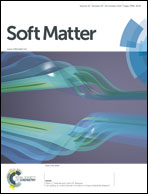Direct observation of the formation and destruction of the inverted continuous oil phase in the micro-outlet region achieved by the confined diluted O/W emulsion stream
Abstract
We demonstrate a direct observation of the oil-in-water (O/W) emulsion droplets in a confined point contact geometry, to shed new light on the mechanism of the interaction between emulsion and solid surfaces under confinement. Significantly, the behavior of droplets at the outlet of the contact area is highlighted. The interference technique offers capabilities to distinguish different phase of liquid based on the divisive refractive indices. A continuous oil phase can be initially obtained surrounding the contact area, at both the inlet and outlet, as a result of the confinement-induced phase inversion, which has been recognized as the efficient reservoir to the contact. However, in the outlet region, such reservoir is observed to be readily destroyed by the backflow of the diluted bulk emulsion, resulting in a notable coexistence of both the O/W and W/O phases in several distinguishing microscopic zones adjacent to each other. This suggests that the breakup of the reservoir may underlie the limited absorption and lubricity of diluted O/W emulsion systems.


 Please wait while we load your content...
Please wait while we load your content...